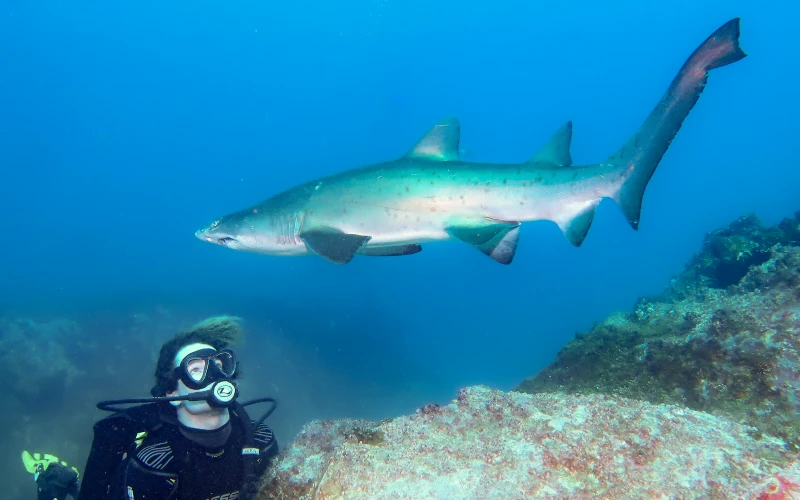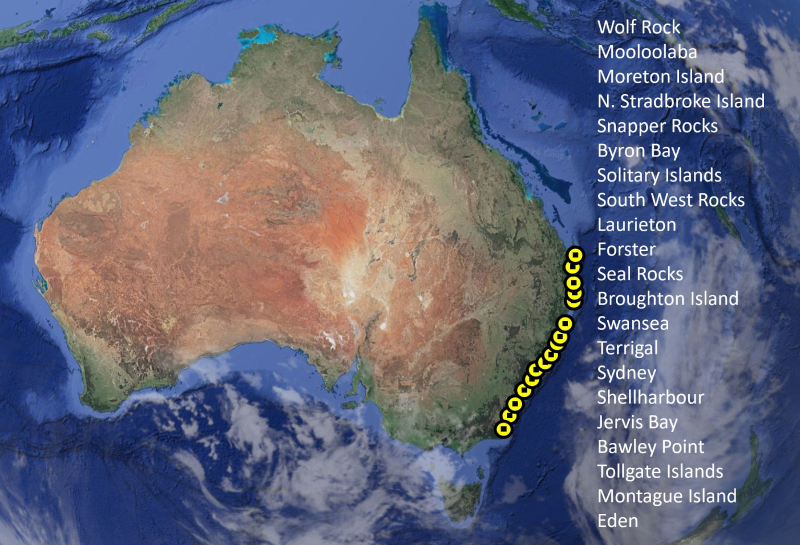About Grey Nurse Sharks
Diving with grey nurse sharks
Known as “Labradors of the sea”, these docile grey nurse sharks are favourites among divers. Their classic shark shape, impressive size, and predictable behavour make them ideal for shark tourism.
With their calm demeanor and easily accessible habitats along the East Australian cost, divers of all skill levels can enjoy encounters with grey nurse sharks. These gentle sharks often reside in reefs, caves, overhangs and shipwrecks, providing stunning backdrops for underwater photographers. NSW and QLD offer some of the best dive sites in the world.
Click here for information the best dive sites to see the East Coast of Australia population of grey nurse sharks.

Appearance and characteristics
Grey nurse sharks are also referred to as sand tiger sharks and ragged toothed sharks, while their scientific name is Carcharias taurus.
They have slender, streamlined body, with a large rounded snout showing prominent, goofy-like teeth. They are greyish-brown in colour with a white underbelly and have distinctive spots along their flanks. Their two dorsal fins are of similar size, and they have a large tail.

Illustration of a grey nurse by Liss Finney for Spot A Shark
Reproduction
Grey nurse sharks are known for their slow reproductive rate, the slowest of all shark species. This slow reproductive rate makes them particularly vulnerable to population declines and is why they are still slowly recovering from their overfishing in the 1960s and 1970s.
Once sexually mature, mating only usually occurs once every two years, with a 9-12 gestation period. These sharks are ovoviviparous, meaning that their eggs hatch inside the female without any placental connection. Interestingly they have two uterus, and before being born, the strongest embryos eat the less developed embryos – survival of the fittest before even being born! As a result they only produce two pups per litter – one per uterus.
Feeding
Diet for grey nurse sharks consists of fish, crustaceans, rays, and other small sharks.
Here is a fantastic video clip from South West Rocks Dive Centre of a grey nurse shark eating.
Buoyancy control
Like many other species of shark, grey nurse sharks use their large oily liver and fins to control their buoyancy. They can be seen swimming to the surface to swallow air. This allows them to hover and appear motionless above the sea floor.
In this video the grey nurse shark can be seen swimming to the surface and gulping air to assist in their buoyancy control. Thanks to Duncan Heuer of @AussieBubbles for this exciting video.
This behaviour might explain the colours of this shark where they are grey/bronze on top and pale underneath their body. This colouring may provide them some form of camouflage when swimming to the surface by making it difficult for their unsuspecting fish prey to distinguish them.
Shark Sightings
Sightings can be few and far between for some individuals. About a quarter of the shark individuals captured within our database have been sighted more than once and across multiple locations. Some individual sharks have been recorded travelling up and down the coast of Australia multiple times over large geographical areas, spanning more than 1000km from end to end.
Recent evidence suggests that whilst numbers of sharks may appear to be increasing, the overall health of the East Coast population is reducing and affecting mortality rates.
All line fishing methods that use hooks have the potential to harm grey nurse sharks. Aside from the countless sightings of these sharks with hooks in their gills, mouth and eyes, autopsies of grey nurse sharks found that hooks can become embedded in the throat and stomach, and can puncture the shark’s large liver. This can lead to bacterial infection, septicaemia (blood poisoning) and ultimately death, and is the largest known source of human-induced mortality of the species.

Distribution
The grey nurse shark population inhabiting the East Coast of Australia represents a genetically unique lineage, separate from other global populations. Due to geographical isolation, these sharks have evolved distinct genetic characteristics. Unlike other shark species that have global migration patterns, the grey nurse sharks in this region are relatively isolated. As a result, the loss of the East Coast of Australia population could lead to the extinction of this genetically distinct population, with no possibility of natural rehabilitation.
The range of the east coast population is approximately 2,700km extending from the Capricornia Coast in Queensland (for example Wolf Rock, near Rainbow Beach), down to as far as the border of New South Wales/Victoria.
Spot a Shark has documented grey nurse sharks making remarkable migrations along the entire East Coast of Australia, travelling from the south to the north and back. While these sharks are capable of long-distance journeys, they also exhibit a tendency to remain in specific locations for extended periods, especially juveniles. Photos show that juvenile grey nurse sharks are commonly sighted around Sydney and Wollongong, while the larger breeding females are often found in the north, from Julian Rocks in Byron Bay to Queensland.

Fun facts
1. Unique spots: Each grey nurse shark has a unique pattern of spots along their bodies as individual as human birthmarks and fingerprints. This distinctive pattern can be used to identify individual sharks.
2. Living fossils: Grey nurse sharks have remained relatively unchanged for millions of years, to almost the age of the dinosaurs. This makes them practically living fossils.
3. Teeth: They replace their teeth every 8-15 days, and may lose around 30,000 teeth in a lifetime!
4. Cannibalism: Within the mother, the embryos sharks engage in a cannibalistic process where only the strongest pup per uterus survives, after eating its siblings. This gives that pup the strongest chance of survival.
5. Slow to reproduce: They have the slowest reproductive rate of sharks, producing only one pup per year on average once they reach sexual maturity.

Where to dive
- Wolf Rock, QLD – https://wolfrockdive.com.au
- Mooloolaba, QLD – https://www.sunreef.com.au
- Moreton Island, QLD
- N. Stradbroke Island – https://www.mantalodge.com.au
- Snapper Rocks
- Byron Bay – https://www.sundive.com.au
- North Solitary Islands – https://woolidive.com.au
- South Solitary Islands – https://jettydive.com.au
- South West Rocks – https://swrdive.com.au
- Laurieton
- Forster – https://www.diveforster.com.au or https://www.forsterdivecentre.com.au
- Seal Rocks – https://www.forsterdivecentre.com.au
- Broughton Island – https://feetfirstdive.com.au
- Swansea
- Terrigal
- Sydney – https://www.urgdiveclub.org.au, https://www.sydneydivecharters.com.au, https://divesydney.com.au, https://www.divebondi.com.au
- Shellharbour
- Jervis Bay – https://www.divejervisbay.com
- Bawley Point
- Tollgate Islands
- Montague Island – https://www.underwatersafaris.com.au, https://naroomacharters.com.au
Eden – https://www.diveeden.com.au

Surveys
If you would like to participate in surveys, or donate money towards population surveys please contact spotashark@gmail.com to learn more about how to help.
The best method is for divers and Dive Shops to encourage photographers to submit photos here or share photos to spotashark@gmail.com to help us continue this study.
